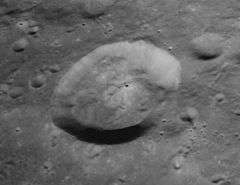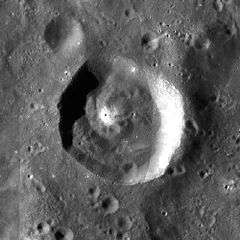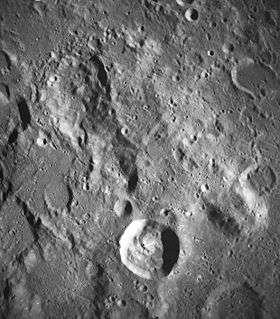Kant (crater)
|
LRO WAC mosaic | |
| Coordinates | 10°36′S 20°06′E / 10.6°S 20.1°ECoordinates: 10°36′S 20°06′E / 10.6°S 20.1°E |
|---|---|
| Diameter | 32 km |
| Depth | 3.1 km |
| Colongitude | 40° at sunrise |
| Eponym | Immanuel Kant |

Kant is a small lunar impact crater that is located to the northwest of the prominent crater Cyrillus and the comparably sized Ibn Rushd. To the northwest is Zöllner, and to the east is Mons Penck. This last feature forms a mountainous promontory reaching a height of about 4 km.
The crater is named after the mathematician Immanuel Kant.
This crater has a well-defined and somewhat uneven rim that is roughly circular in shape. The inner walls have a higher albedo than the surrounding surface, giving them a lighter appearance. Parts of the inner wall have slumped across the inner floor, producing an irregular surface. At the midpoint of the interior is a low central rise, with a craterlet at the summit, giving the appearance of terrestrial volcano, although the peak is probably not volcanic.
Satellite craters
By convention these features are identified on lunar maps by placing the letter on the side of the crater midpoint that is closest to Kant.
| Kant | Latitude | Longitude | Diameter |
|---|---|---|---|
| B | 9.7° S | 18.6° E | 16 km |
| C | 9.3° S | 22.1° E | 20 km |
| D | 11.5° S | 18.7° E | 52 km |
| G | 9.2° S | 19.5° E | 32 km |
| H | 9.1° S | 20.8° E | 7 km |
| N | 9.9° S | 19.7° E | 10 km |
| O | 12.0° S | 17.2° E | 7 km |
| P | 10.8° S | 17.4° E | 5 km |
| Q | 13.1° S | 18.8° E | 5 km |
| S | 11.5° S | 19.7° E | 5 km |
| T | 11.3° S | 20.2° E | 5 km |
| Z | 10.4° S | 17.5° E | 3 km |
References
- Andersson, L. E.; Whitaker, E. A. (1982). NASA Catalogue of Lunar Nomenclature. NASA RP-1097.
- Blue, Jennifer (July 25, 2007). "Gazetteer of Planetary Nomenclature". USGS. Retrieved 2007-08-05.
- Bussey, B.; Spudis, P. (2004). The Clementine Atlas of the Moon. New York: Cambridge University Press. ISBN 978-0-521-81528-4.
- Cocks, Elijah E.; Cocks, Josiah C. (1995). Who's Who on the Moon: A Biographical Dictionary of Lunar Nomenclature. Tudor Publishers. ISBN 978-0-936389-27-1.
- McDowell, Jonathan (July 15, 2007). "Lunar Nomenclature". Jonathan's Space Report. Retrieved 2007-10-24.
- Menzel, D. H.; Minnaert, M.; Levin, B.; Dollfus, A.; Bell, B. (1971). "Report on Lunar Nomenclature by the Working Group of Commission 17 of the IAU". Space Science Reviews. 12 (2): 136–186. Bibcode:1971SSRv...12..136M. doi:10.1007/BF00171763.
- Moore, Patrick (2001). On the Moon. Sterling Publishing Co. ISBN 978-0-304-35469-6.
- Price, Fred W. (1988). The Moon Observer's Handbook. Cambridge University Press. ISBN 978-0-521-33500-3.
- Rükl, Antonín (1990). Atlas of the Moon. Kalmbach Books. ISBN 978-0-913135-17-4.
- Webb, Rev. T. W. (1962). Celestial Objects for Common Telescopes (6th revised ed.). Dover. ISBN 978-0-486-20917-3.
- Whitaker, Ewen A. (1999). Mapping and Naming the Moon. Cambridge University Press. ISBN 978-0-521-62248-6.
- Wlasuk, Peter T. (2000). Observing the Moon. Springer. ISBN 978-1-85233-193-1.
External links
| Wikimedia Commons has media related to Kant (crater). |
- LTO-78C1 Kant — L&PI topographic orthophoto map.

